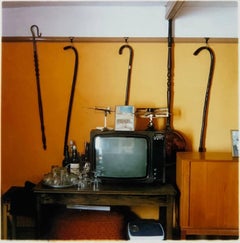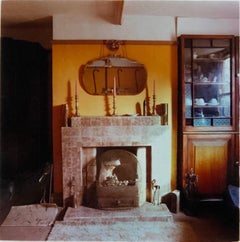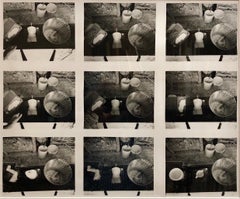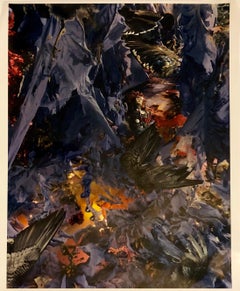1980s Still-life Photography
to
3
36
39
36
20
10
Overall Width
to
Overall Height
to
7
555
4,740
1
1
9
11
11
24
24
37
141
185
84
13
10
6
2
1
64
53
24
25
23
20
15
15
13
10
10
9
8
8
7
7
7
7
6
6
6
6
5
73
64
54
53
39
32
19
13
10
4
16
9
78
62
Period: 1980s
Orthochromatic Negative (Antique Olivetti Typewriter)
By Samuel Field
Located in Cambridge, GB
This bold graphic piece fantastically captures the iconic Italian Olivetti Typewriter.
This artwork is a limited edition of 25, lustre photographi...
Category
Conceptual 1980s Still-life Photography
Materials
Photographic Paper, Black and White, C Print, Silver Gelatin
Sticks, Manea
Located in Cambridge, GB
Richard Heeps’ seductive, highly saturated colours and sophisticated pictorial structures demonstrate a true love and empathy for his subject matter – be it cool, descriptive interio...
Category
Contemporary 1980s Still-life Photography
Materials
Photographic Paper, C Print, Color, Silver Gelatin
Candle Sticks, Manea
Located in Cambridge, GB
Richard Heeps’ seductive, highly saturated colours and sophisticated pictorial structures demonstrate a true love and empathy for his subject matter – be it cool, descriptive interio...
Category
Contemporary 1980s Still-life Photography
Materials
Photographic Paper, C Print, Color, Silver Gelatin
Vintage Silver Gelatin Photograph Surrealist Fake Limb Prosthetic Factory Photo
By Shimon Attie
Located in Surfside, FL
These are vintage prints from the 1980's. The last photo shows of a label from an accompanying piece (there were three sequence shots in this series) but is not on this piece. They l...
Category
Conceptual 1980s Still-life Photography
Materials
Silver Gelatin
Relics 2 Elaborately Constructed Vintage Color Photograph Surrealist Image
By Jane Calvin
Located in Surfside, FL
Chromogenic photo print. hand signed, titled and dated. This is a vintage print, printed in 1987 and editioned 2/10.
Jane L. Calvin (born April 27, 1938) is an artist based in Chicago, Illinois.
Jane Calvin was born in Chicago, Illinois. Her father was an avid art collector and Calvin was brought up in the art world from the time she was born. She attended classes at the Art Institute of Chicago as a young child and went on to pursue a degree in Art History from Bryn Mawr College in Pennsylvania in 1959. Calvin worked as a private art dealer for some time before deciding to continue her education and become a fine art photographer. She graduated from the Art Institute of Chicago with her MFA in 1982.[1] Calvin later went on to be a Professor of Photography at The School of the Art Institute, Illinois Institute of Technology, and Beloit College. She was Adjunct Professor of Photography at Columbia College in Chicago until 2005. Since she started making photographs, Calvin has had exhibits across the nation as well as in Germany and China.
Calvin constructs her photographs by montaging multiple slide projections and found objects into room-sized assemblages in her studio. She then photographs it, making a tableaux into which layers of meaning are woven. She does not use computer editing, just straight photography. Calvin stated, "The images can be seen as my commentary on the political and social roles projected onto society whose desires, manipulated by language and image, conflict with concerns of gender, sexuality, race and female identity."
She says,“I make photographs, I don’t take them,” and in so stating she follows in the path of many Dada and Surrealist precursors, for example, German Kurt Schwitters’ famous Merzbau or Junk House (1923 and following), or Joseph Cornell’s metaphorically vast but physically modestly scaled, even private sculptural interiors of boxes (1930s and following). In her use of projected imagery within and upon the setup of her photographs, Calvin gestures toward earlier 20th century American surrealist photographer Man Ray photographic work, one example of which is Space Writing (Self-Portrait) acquired last year by the Bowdoin College Museum of Art. Calvin’s more recent kindred spirit – although comparatively minimalist in nature and junior chronologically – is Sandy Skoglund. The latter’s photographed installations are a hybrid of unnatural, spectral, coloration and suspended narrative. "I am a maker of meaning, not an observer of it. My medium is photography, although it is includes the processes of sculpture and installation . I build room-sized sets onto which I project images and text, recording the final result with the camera. There are no darkroom or digital tricks. The process is straight photography."
For over 25 years, Calvin has been exploring contemporary society’s approach to issues of gender, female identity, sexuality, vulnerability, and love & desire. Eschewing linearity, the work stands in opposition to the simplicity and minimalism prevalent in earlier 20th century image-making. Her images are elliptical, fragmented, layered, reflecting the contemporary world as one of discontinuity and ambiguity with myriad connections, a world less temporally and spatially fixed than ever before. Through the content carried in found materials and appropriated texts, –she addresses— the social and political conditions that are just out of sight, but remain like some kind of background radiation exerting a subtle but undeniable influence on our society. Pop and pulp references throw a humorous light on cultural identity and gender roles projected onto society. The subject matter, appearing disconnected from its place and time, mysteriously overlaps our own collective awareness. –She asks the viewer to see what has been there all along.–—/> Exhibition publication, Gallery 210, University of Missouri, St Louis, 2005, 'Jane Calvin Sentences' Introduction by Terry Suhre, Director, and Essay "Jane Calvin's Phantasmagoric Spaces" by Dr. Mark White.
This is a Set-Up: fab photo/fictions This exhibition looked at photographers who utilize fabricated imagery and constructed subjects to create their work. These deliberate fictions, and their position in the realms of photography and art, were explored through the work of several highly acclaimed artists: Jane Calvin, James Casebere, Gregory Crewdson, Barbara Kasten, Abelardo Morell, Patrick Nagatani...
Category
Surrealist 1980s Still-life Photography
Materials
C Print
Slim Aarons 'Pool on the Amalfi Coast' (Slim Aarons Estate Edition)
By Slim Aarons
Located in Los Angeles, CA
A view of the seaside pool at the Hotel St. Caterina, Amalfi, Italy, September 1984.
Slim Aarons
Pool on the Amalfi Coast
Chromogenic Lambda ...
Category
Realist 1980s Still-life Photography
Materials
Lambda
Toys
By Andy Warhol
Located in Santa Monica, CA
This work was acquired directly from The Andy Warhol Foundation for the Visual Arts. The work is in pristine condition and has never been framed.
This is a unique work which comes w...
Category
Pop Art 1980s Still-life Photography
Materials
Polaroid
Airplane
By Andy Warhol
Located in Santa Monica, CA
This work was acquired directly from The Andy Warhol Foundation for the Visual Arts. The work is in pristine condition and has never been framed.
This is a unique work which comes w...
Category
Pop Art 1980s Still-life Photography
Materials
Silver Gelatin
Large Cibachrome Color Photograph LA Woman Artist Dress, Feminist, Photo C Print
Located in Surfside, FL
A large scale Cibachrome photograph.
An abstract work from the series titled, "Fairfax Ladies," (the historic old Jewish neighborhood of Los Angeles) produced 1983. The subject was created through by placing diaphanous fashion garments onto photo-sensitive paper, embellishing them with objects, paper bits, and flora, and layering in painterly surfaces with scratches, completely covering the image. The series won a prize in the BCibachrome competition (1985), sponsored by BC Space Gallery (Laguna Beach, CA), and was exhibited at "Robin Valle: From Darkroom to Digital, Works from 1974-2009," posthumously presented August 2009 at El Camino College Gallery (Torrance, CA). Work presented under plexiglass in a custom wood frame.
Work Size: 39.5 x 29.5 in.
Framed Dimensions: 43.5 X 33.5 X 2 in.
Valle, Robin Joy (1953-2009)
After receiving her BA from SMU and an MFA in Photo/Cinematography from the University of Illinois in 1977, she moved to Los Angeles. Valle exhibited her one-of-a-kind Cibachrome photographs at galleries and museums locally and nationally. In 1982, she was selected for the NEA funded, "Life in LA" project, sponsored by the Los Angeles Women's Building. Valle taught photography at many Southland colleges as well as the LA County High School for the Arts. She was one of the first LA based photographers to explore digital media, receiving an Innovative Instruction Grant from Chaffee College in 1989 to create their first photography class in digital media. In 1998 she became a member of the full-time faculty at El Camino College, where she was instrumental in developing the Digital Arts program. Her work ranged from Black and white photographs to colorful, intricately layered patterns that command the gallery walls.
It isn’t surprising that she, along with fellow art instructor, Joyce Dalal, contributed largely to the ECC art department’s merge towards digital art. As one of the first local photographers to explore digital media, she was crucial to the development of the Digital Arts Program.
Before computers became commonplace, Valle’s techniques show a digital influence. “Her work was always inventive”, said ECC art curator, Susanna Meiers. An effect that can easily be done now with a few mouse clicks on Adobe Photoshop, required a long process of rubbing dye into the actual photograph in the ’70s. Her methods of illustrating were just as unique as the topics themselves. Photographs of the violent Chinese protest at Tiananmen Square in 1989 where military response murdered protestors in large numbers included photographing images from her television screen. “Crime Stats/ Hollywood” was a theme she dedicated to the gang violence around her neighborhood in the early ’90s. With washed out gang members as the focal point,
and graffiti as well as mapped out grids of Los Angeles as the backdrop, Valle’s layering, collage-like technique is continued on and more developed. “There is a fanciful, imaginary quality of her work,” said Meiers. From her quirky pieces of birds, zebras, and even dinosaurs enveloped in patterned, colorful, designs to her more serious themed feminist pieces, her eclectic, colorful style breaks through. Her feminism is on display in “Expectations” which illustrates women’s ability to “look good and produce children.” A bright human embryo steals your attention dead center, with a “June Cleaver” type 1950’s woman smirking at you from either side of it. A mustard yellow backdrop, brings the entire piece together illustrating society’s views of women as well as her playfulness as an artist. “Robin was terribly funny and had a laugh that would just set people off,” Meiers said. The art curator designed a section of the gallery similar to Valle’s apartment. A bright pink shelf...
Category
Contemporary 1980s Still-life Photography
Materials
C Print
Anguilla, BWI, 1989
By Robin Rice
Located in Hudson, NY
Listing is for UNFRAMED print. Inquire within for framing.
Edition 5 of 25
After 30 years on West 11th Street, The Robin Rice Gallery celebrates its first ever exhibition for Robin...
Category
Contemporary 1980s Still-life Photography
Materials
Silver Gelatin
Untitled #106 by Jo Ann Callis, 1980, Vintage C-Print, Still Life Photography
Located in Denton, TX
Untitled #106 by Jo Ann Callis presents a black bird hovering over a table with a layered strawberry cake. The raven flies over the table setting, with it's wing cutting across the center of the image. The bird appears to gaze downward, perhaps looking at the slice of cake as it's next meal.
This vintage c-print measures 24 x 20 inches, and is presented matted with a silver metal frame, measuring 28.38 x 23.38 x 1.13 inches. This photograph is signed and dated in ink on the verso. This photograph was acquired from the Atlantic Richfield Company.
Jo Ann Callis was born in Cincinnati, OH and relocated to Los Angeles in 1961. She enrolled at UCLA in 1970 where she began taking classes with Robert...
Category
Contemporary 1980s Still-life Photography
Materials
Color
Cactus- Signed limited edition still life print, Black white nature, Contemporary
Located in Sant Cugat del Vallès, Barcelona
Cactus - Signed limited edition archival pigment print, 1989 - Edition of 5
This image was captured on film.
The negative was scanned creating a digital file which was then prin...
Category
Contemporary 1980s Still-life Photography
Materials
Archival Paper, Black and White, Archival Pigment, Photographic Film, Pi...
Crabs
By Andy Warhol
Located in Santa Monica, CA
This work was acquired directly from The Andy Warhol Foundation for the Visual Arts. The work is in pristine condition and has never been framed.
This is a unique work which comes w...
Category
Pop Art 1980s Still-life Photography
Materials
Polaroid
Eggs (Cape Cod, Mashpee Flea Market)
By Andy Warhol
Located in Santa Monica, CA
From The Jon Gould Collection of Andy Warhol Photographs
Each photo is unique and blind embossed “Andy Warhol” in the lower right corner
Provenance: Gift of the Artist to Jon Goul...
Category
Pop Art 1980s Still-life Photography
Materials
Silver Gelatin
Japanese Toy
By Andy Warhol
Located in Santa Monica, CA
This work was acquired directly from The Andy Warhol Foundation for the Visual Arts. The work is in pristine condition and has never been framed.
This is a unique work which comes w...
Category
Pop Art 1980s Still-life Photography
Materials
Polaroid
Untitled #115 by Jo Ann Callis, 1980, Vintage C-print, Still Life Photography
Located in Denton, TX
Untitled #115 by Jo Ann Callis presents a hat and pair of gloves on a table with 7 cherries placed below. A small black bird perches on top of the hat, looking down at the fruit scattered on the table.
This vintage c-print measures 24 x 20 inches, and is presented matted with a silver metal frame, measuring 28.38 x 23.38 x 1.13 inches. This photograph is signed and dated in ink on the verso. This photograph was acquired from the Atlantic Richfield Company.
Jo Ann Callis was born in Cincinnati, OH and relocated to Los Angeles in 1961. She enrolled at UCLA in 1970 where she began taking classes with Robert...
Category
Contemporary 1980s Still-life Photography
Materials
Color
Church Window, Bridge Haven, California
By Rod Dresser
Located in Carmel-by-the-Sea, CA
Signed on the front. Special Edition Print.
Category
1980s Still-life Photography
Materials
Digital Pigment
"Color Chart", 1982, Color Photograph by Anne Turyn
By Anne Turyn
Located in Long Island City, NY
Artist: Anne Turyn, American (1954 - )
Title: Color Chart
Year: 1982
Medium: Photograph
Size: 16 x 20 in. (40.64 x 50.8 cm)
Frame Size: 27.5 x 32 inches
Category
Post-Modern 1980s Still-life Photography
Materials
Photographic Paper
Piñatas Apiladas, (stacked piñata pots)
Located in Denton, TX
Open Edition
Gelatin silver print, 13 3/4 x 18 in.
Signed, titled, and dated in pencil on print verso by Mariana Yampolsky
Printed 1998-99
Category
Contemporary 1980s Still-life Photography
Materials
Silver Gelatin
'Chairs - Paris' original photograph by Leslie Borns
By Leslie Borns
Located in Milwaukee, WI
This image of empty broken chairs in a deserted alley is reminiscent of the work of Eugene Atget, who was capturing the streets of Paris over a 30 year pe...
Category
Contemporary 1980s Still-life Photography
Materials
Photographic Paper
Dark Sun No. 7
Located in New York, NY
For the past 30 years Barbara Jaffe has used her 4x5 inch view camera and a variety of black & white and expired pos/neg Polaroid films to create photographs that are a tribute to th...
Category
Contemporary 1980s Still-life Photography
Materials
Archival Pigment
Classical Bust with Orchids, New York, 1988
Located in New York, NY
Signed by the photographer
Edition 9/10
Category
1980s Still-life Photography
Materials
Platinum
Bust with Ties, Paris
Located in New York, NY
Signed by the photographer
Category
Modern 1980s Still-life Photography
Materials
C Print
Roses with Antique Head
Located in New York, NY
Photographer’s stamp on the verso
Category
1980s Still-life Photography
Materials
Photographic Paper
The Empty Chair
Located in New York, NY
Gelatin silver print
Signed, titled, and dated in pencil, verso
This artwork is offered by ClampArt, located in New York City.
Over the course of more than two decades, Bruce Crats...
Category
Other Art Style 1980s Still-life Photography
Materials
Silver Gelatin





